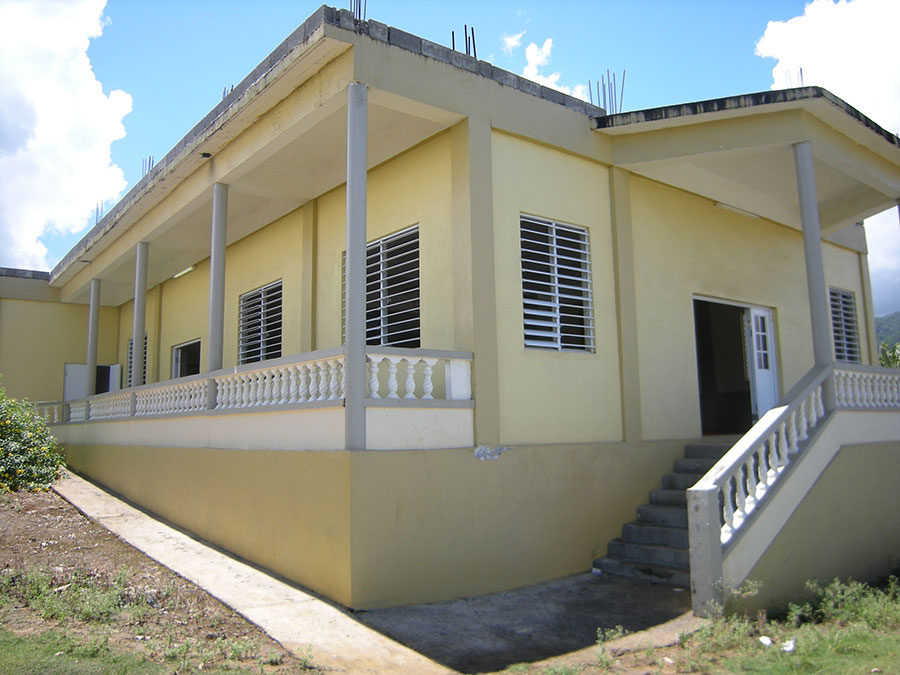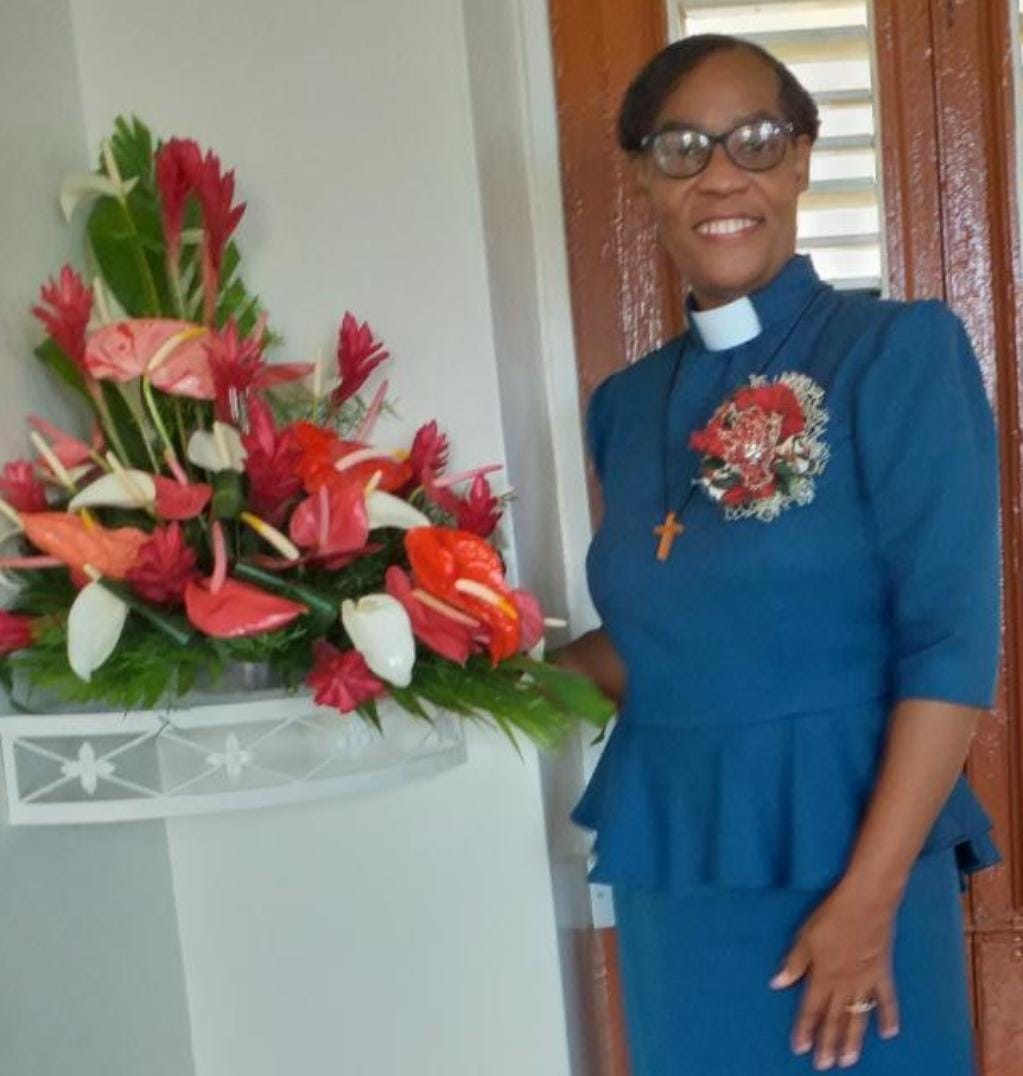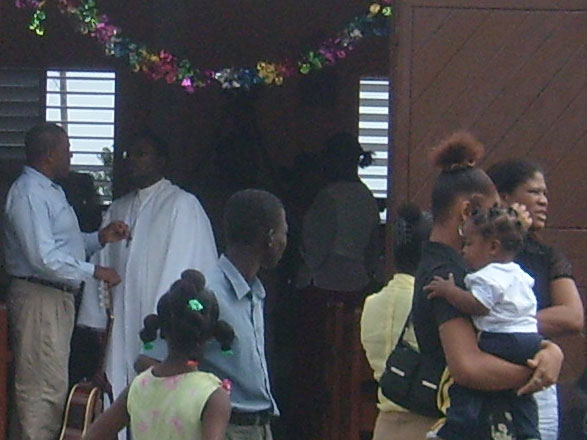
The history of Methodism in Dominica started with the arrival on the sixth of January in Portsmouth 1787 of Dr. Thomas Coke with three other preachers- Baxter, Hammond and Clarke from Antigua. The work in the Church in Portsmouth is even more interesting.
The first Missionary, an Irishman, the Rev. William McConnel was the first Preacher to work in the Portsmouth community. At the time, two centers existed in Dominica - Portsmouth and Roseau. McConnel did not survive the Portsmouth environment. He contracted Malaria or yellow fever and died after six months.
In the early years, there were gaps between ministers as many succumbed to the diseases of the day. The little flock was left like sheep without a shepherd. No missionary was sent for the next six years. The Church was still in its infancy. In these early years, a lay leadership had not been developed, so things fell apart.
The next Minister arrived in 1794 - John Cook. He did not last very long. The early Missionaries who came to Portsmouth had serious conflicts with the planters. Slavery was still in existence, the Missionaries’ messages were reaching slaves, and therefore many planters saw these Missionaries’ philosophy and faith in conflict with their own. This created some tension.
Planters took on a hostile attitude towards the Methodist evangelists, accused them of subversive activities. One Minister, John Cook was asked to serve in the local militia.
In 1796, he prayed to be exempted from military exercises on a Sunday but: ‘the President, after he had heard the petition, told him that he had been informed that he was a suspicious character, who disseminated pernicious doctrines among the slaves and instead of being exempted from military duty, he would compel him to quit the island, and gave him the order accordingly, with which order he was obliged to comply, to avoid imprisonment (Honychurch, 1995).
When the first Missionaries sought leave to visit the slaves, they met with reluctance, and even hostility, on the part of many of the planters; this was only overcome by the evidence that conversion improved the value of the slaves as servants, making them diligent and honest and disposed to work with goodwill.
Rev. Thomas Dumbleton was the next missionary who followed in 1798 he was warned by the Governor to ‘toe the line or else’ he would follow the same fate as his predecessors.
The society which was greatly reduced began to revive. In these early days, class and society meetings helped the church to flourish.
Rev. Dumbleton was succeeded by the Rev. Joseph Bocock, sadly, he died shortly after his coming. However, he made a good impression in Roseau and a large sum of money was collected for his widow’s fund. He seemed to have overcome some of the hostility and to dispel some of the prejudice against Methodists that had existed with his predecessors.
Mr. Thomas Richardson another missionary who worked in Portsmouth. He commented on the piety of the congregation and their willingness to pray and declare what God had done for them in their lives. Methodism grew rapidly and benefitted tremendously from their early denunciation of slavery. Methodism offered the African slaves a sense of community and it was a way of building a sense of ethnic solidarity. The teachings offered them choice, an alternative with its emphasis on spirituality, revival, conversion, experience and the Bible. Christianity lifted the slaves spirits as slavery had casted them, giving them a diminished sense of humanity. It offered them heaven on earth—Salvation which is open to all not just a selected few. Methodism offered uplifting songs not a message dominated by feelings of depravity or unworthiness but of personal worth, affirmation and deliverance.
One of the other challenges for the early missionaries had to do with the size of Dominica. No one man could do justice with the missionary work. Those who resided in Roseau had better prospects. Although Portsmouth had better prospects for missionary work, as slaves flocked to the services, and the congregation doubled. But alas, the problem with Portsmouth was the swap conditions, and missionaries suffered from the local epidemics.
The missionary appointed to Portsmouth in 1803 Thomas Richardson, a Yorkshire man, who was very active and aggressive in his ministry. The congregation expanded rapidly during his tenure. A revival broke out among the people. Persons came from all over the neighboring villages to worship membership grew from six hundred to over one thousand. Churches were always filled. Though the Roman Catholic Church was the religion of the country but they had only three to four priests working on the island. The Church of England had a small congregation in Roseau. Methodism because of its style and content was easily appropriated to the population, who were under duress and in need of something emotionally satisfying. It was a vehicle for religious expression. Hence, Methodism grew rapidly during these early years. After eight months of toil on the island the enthusiastic young Yorkshireman died in October, 1803.
Rev. Dumbleton returned again to work in the society in 1805 as Superintendent to Dominica. In 1804 the church approached the then Governor at the time for land to erect a worship center and manse. Governor George Prevost responded positively by giving the church 43,000 acres on the condition that within a year the church had to be built. It was then that the first chapel, wooden structure with a thatched roof, was built. Sadly, a severe hurricane of 1813 destroyed that chapel.
With a rapidly growing congregation, the need for a larger building became evident and second chapel was built on the lot of land boundaries being lots 43, 44 and 45 in the centre of Portsmouth. This property was property given to the church by a planter Elizabeth Wallis. She had given most of her property in the Clifton area to the church as well. This is how the name for Portsmouth Methodist Church originated—Mt Wallis. A stone structure was built for use as a worship centre. This structure was destroyed by an earthquake in 1843.
This period 1815-1843 was the best period in terms of the size on the Prince Rupert/Portsmouth congregation. No Minister was stationed until Rev. John Parkes in 1832. Rev. Parkes started schools on many estates among the labourers. First, they started as Sunday Schools, but these extended as estate managers gave permission, the teachings extended into formal education. In Portsmouth the Hon. D.S. Laidlow gave his mansion at Sugar Loaf Estate for missionaries to preach and teach on Sabbath evenings. In those days, Methodism was held in high repute. Whenever, the Governor was in town he went to service.
Later, the records show that the church bought land in Zicack, for a meager sum of 5 shillings from a planter. With emancipation looming in the air, slave trade was abolished, many estates faced economic problems – high debts, credit non-existent and supplies in short supply because of the Revolutionary War many planters disposed of their property during those years. This planter was selling off his property and offered some to the church. This planter owned the whole of the Zicack and Chance areas of Portsmouth. Many of the Prince Rupert congregation worked on that estate or lived in those areas. The erection of a church in that area would make church attendance easier for followers in that part of Portsmouth. Even today, most Methodists still live in the Zicack area of Portsmouth.
Reverend Waymoth was another missionary who served in the Portsmouth area. It was during his ministry that the church acquired land in Zicack. After the destruction of the second chapel He started construction on the third church building. The new church and manse was constructed on the Zicack site. The Rev. John Horsford, an Antiguan was the first minister to occupy the manse.
The unhealthiness of the climate in Portsmouth forced the authorities to transfer serving ministers from Portsmouth to La Soir. A church was opened in that area and for many years, Portsmouth was served from the Wesley area. One of the significant highlights of his ministry was the conversion of an estate manager, living with a woman who was not his wife. He came into contact with Rev. Horsford and because of Horsford’s influence he ended the living arrangements with the woman, converted and began to worship. This had a huge impact in the Marigot and Wesley areas. In those days, Portsmouth station was served from Wesley.
It was not until 1844 that the church manse was completed and the first minister occupied the manse. Rev. Horsford was a very dynamic missionary. Now three ministers existed on the island.
RECONSTRUCTION, AND NEW ISSUES - 20TH CENTURY
The twentieth century began with agitation among Portsmouth residents and the Minister for a chapel. The wooden structure which was built was now dilapidated and falling apart. Members felt it was time for a new building. Rev. G. A. Eliott was the first minister to serve in the area at the beginning of the century. He too did not last long, he took ill and died. Portsmouth has a history of being deadly to a number of ministers. The minister who succeeded him was Rev. John Hawshaw.
Rev. Hawshaw was sent to work in Guyana, but for whatever reason he was not given permission to enter that territory. All other stations was filled, so he was sent to Portsmouth. Another minister who served in that period was Rev. Richardson. He was a retired Minister, who was given the option to return to England or stay in Dominica. He chose Dominica, however he died within one month.
Rev. John Burton was another Minister who served in Portsmouth as his first station. He took ill with malaria. Upon recovery, he lost his voice to a mere whisper, however, he continued giving service, ‘the whispering Minister’. His work was described, as the ‘best Missionary who served in the island.
Rev. J. W. Acres served the Portsmouth community for one or two years before he was transferred to Marigot. He was succeeded by Rev. Belboda, he too was an interesting Minister. Upon retiring he returned to Dominica to reside and he died here as well. He married into a well-known Dominican family - the Bellots. He started the construction on the next church building in 1915-16 but he was transferred before it was completed.
In those days there was a lot of controversy over where the church should be built. The Portsmouth leadership could not agree, they made threats. They argued that the old building should be repaired and continued to worship in the dilapidated building. Anyway for one year the matter was rested.
In a Quarterly Meeting E.A. Caines moved a motion which was seconded by Mr. Lockhart, that they saw no reason to move the church from Zicack to Portsmouth. The motion was passed unanimously. The property in central Portsmouth was then sold to Nicholas Lovell for $180.00. In 1917 the new and fourth church building was completed at a cost of £1100 pounds sterling, on the Zicack site. In addition, £300.00 was given as a grant to the church from the mother church in Britain. Interestingly, 1/10th of the funds or £138.00, was collected from the offering at the stone laying ceremony. The building was completed in 1918, free of any debts.
For a large part of the twentieth century, no Minister pastored Portsmouth. Lay Preachers and Class Leaders continued the work feverishly. When there was no help, the laity kept the church alive. Even today, there is still a strong presence of local preachers. Mt Wallis church is one of the few churches where the class meetings still a strong tradition. Class meetings kept people together, giving us that warm family feel. This strong sense of lay leadership meant that Portsmouth members took charge of their church business.
In 1931 the Rev. E Howard Thomas was appointed to Portsmouth. He was the resident minister for the next four years. He baptized persons like Rev. William W. Watty among others. When Rev. Thomas left Portsmouth was left without a resident Minister until the 1940’s. The 1940’s was the beginning of the Boy’s Scout movement. Rev. Barret started the movement in Marigot during those years. A stalwart, Mr. Harold Thomas, was one of the chief Scout Leaders and a pioneer of the Scout Movement in Portsmouth. His wife was another strong member in those days.
Lucina Thomas (1905 – 2005) and her husband Harold were devout and active members of the Methodist Congregation in Portsmouth. Mrs. Thomas did everything from polishing the offering plates to washing communion glasses as a Poor Steward. She held a variety of positions. She was a Sunday School Teacher, a Local Preacher, a Choir Member and
Member of the Women’s League of which she held several posts including that of President. She was a Society Steward and Church Secretary.
In 1935 Rev. Belboda had become a supernumerary and came back to live in Portsmouth and served for a second time in Portsmouth.
Many other ministers have served over the years F.T. Squire an Englishman served 1939 for one year he was transferred to Marigot. In 1943 Rev. K.G. Swanston, he too served for one year. Rev. James Poor served 1960s. The problem with Portsmouth is that in those days there was no consistent pastoral oversight. Under Rev. Franklyn Roberts as Superintendent the Manse was repaired.
Other Ministers who served faithfully included Rev. Peter Harris, Lloyd Brisset, Oscar Mathura, Raymond Neily, Relis Martin-Riley, Williams & Joyce Rohan, Rev. Lake, Rev. G. Louis-Charles, among others.
The building built in 1917 had become old and dilapidated and so the membership began to raise fund to build a church hall. Numerous work teams from the United States to contribute to this Faith Church Hall. The earthquake of 2004 finally destroyed the church building of 1917.
On a typical Sunday morning today you will see about 100 members in our worship in church family. On this occasion of the celebration of 223 years of Methodism, we must salute some of our pioneers.
Lay Preachers: N.E.B. Watty, E.A. Caines, George Lanis (Olive Issac’s Uncle) Harold Thomas, E. H. Richards (policeman), Edward Mills, Rudolph F. Thomas, Thomas Irish and Sis Alice Peter, Irasa Wade, Murphy Wallace, Julian Brewster, Neville Wade, among others
Sunday School Leaders: Mrs. Lucina Thomas, Mrs. Unida Dyer, Mr. Ernis Edwards
Organists: Mr. Asquith Caines, Mrs Mable Africa, Edward Mills, Jeanita Thomas
Women’s League stalwarts: Josephine Connor, Louisa Irish, Cora Irish, Mrs. Isabella Wade, Christiana Cornor, Gertude Jarvis, Coralie Holsborough, Hannah Dupigny, Irasa Wade, among others Class Leaders: Bro. Lockhart, Christiana Richards, George Connor, Margaret Watty, Dorcas Connor-Charles, Christiana Connor, Rufus Dyer, Leona Pascal, Celestine Watty Ruth Musgrave, Edel Caines
Benefactors: A. A. Baron, grandfather of Frank Baron, who donated land to the Church to be used as a burial site, a site which is still in use today
The Mt. Wallis Church presently has a population of one hundred and fifty-nine members. Our oldest living member is Mrs. Christian Mills-Francis (94). The fire of new life, which was kindled in many hearts by these pioneers, will continue to grow as we hold aloft this light.
“GREAT IS THY FAITHFULNESS, LORD UNTO US!!”
Honychurch, Lennox (1995) The Dominican Story.
MacMillan, London





